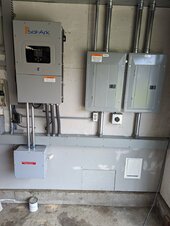Hedges
I See Electromagnetic Fields!
- Joined
- Mar 28, 2020
- Messages
- 21,082
Don't include PV backfeed when totaling loads. (It drives current opposite direction, similar to turning off a load.)
You might want a safety switch for the branch going to PV. Others don't need it.
Without PV, you could have connected main lug only panels rated at least same as main breaker.
Given PV backfeed to that Meter Main, a main lug only panel would need to be rated for Main Breaker + PV backfeed.
Just use main breaker panels. Protected by their own main breaker, they can be 200A, 100A, whatever.
Note that any wires connected to meter main have Main Breaker + PV current available, so size or protect accordingly.
You might want a safety switch for the branch going to PV. Others don't need it.
Without PV, you could have connected main lug only panels rated at least same as main breaker.
Given PV backfeed to that Meter Main, a main lug only panel would need to be rated for Main Breaker + PV backfeed.
Just use main breaker panels. Protected by their own main breaker, they can be 200A, 100A, whatever.
Note that any wires connected to meter main have Main Breaker + PV current available, so size or protect accordingly.



